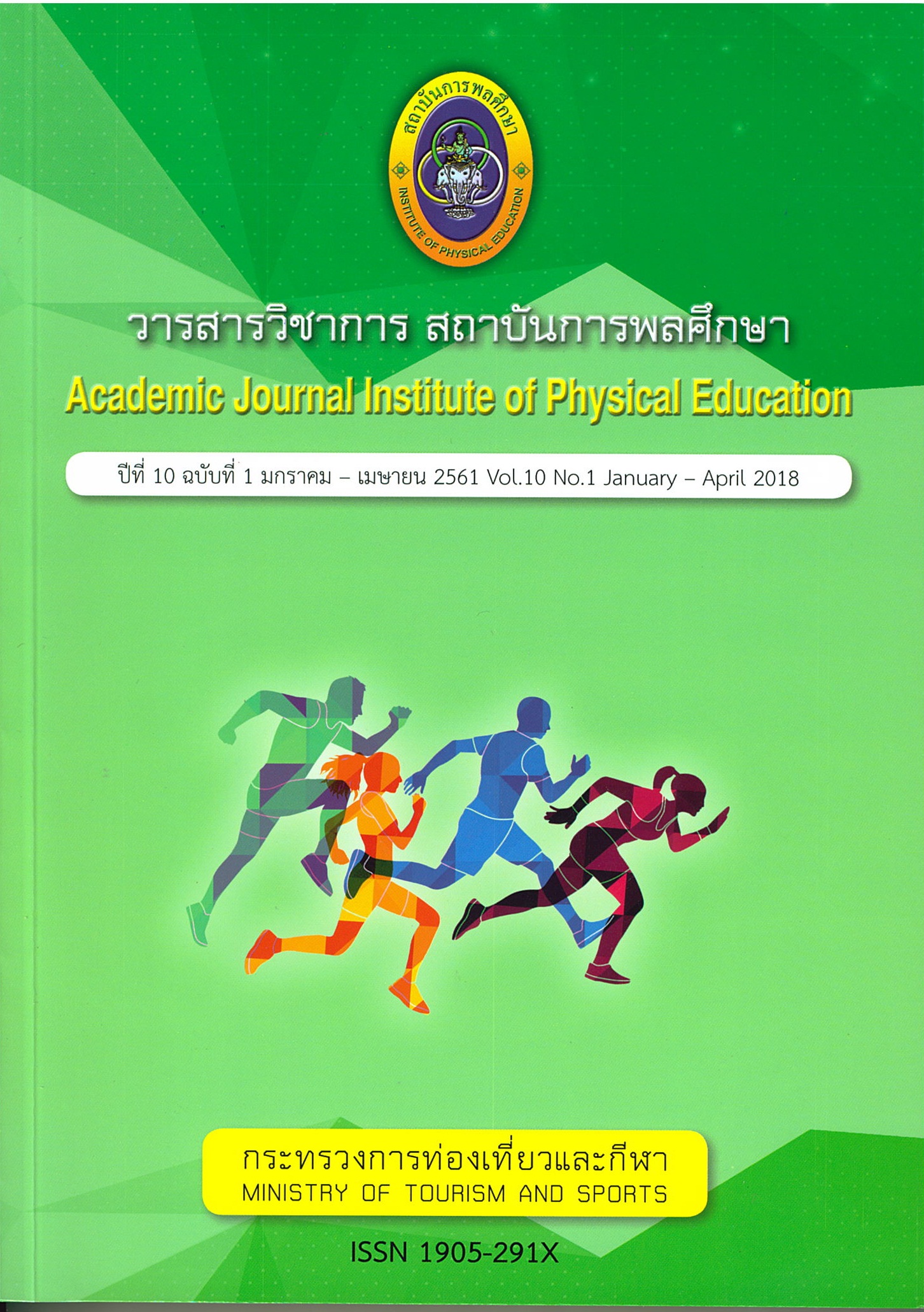A Comparative Study of different Techniques in Recovery Period of Physical Fitness of Athletics
Main Article Content
Abstract
The objective of this study was to compare the physical recovery of athletes using different recoverying techniques: physical recovery by massage recovery,cold water immersion recovery, stretching recovery and rest recovery.Thirty male amateur football and futsal players aged 19-22 years participated in this study were form the Institute of Physical Education Samutsakhon Campus. They were asked to perform a 30s–Wingate anaerobic cycling test until exhausted and were immediately assigned to recovery methods by random selection: 1) massage recovery, 2) cold water immersion recovery 3) stretching recovery and 4) restrecovery.Variables in this study were lactic acid concentration.
It was found that the 4 recovery methods reduced the blood lactate concentration significantly following high intensity cycling. In comparison among 4 recovery methods, massage recovery was the quickest method to reduce lactic acid. However, there were no significant differences between the cold water immersion recovery and stretching recovery. It is suggested that massage method may be the most effective in physical recovery after exercise in this experiment.
Article Details
The published article is a copyright of the Academic Journal of Thailand National Sports University. The passage appeared in each article in this academic journal is a perspective of each author which is not related to the journal. Each author is required to be responsible for all components of his/her own article. If there are any mistakes, each author must be responsible for those mistakes on his/her own.
References
โครงการฟื้นฟูการนวดไทย. (2541). ตำราการนวดไทย.กรุงเทพฯ: โครงการฟื้นฟูการนวดไทยมูลนิธิสาธารณสุขกับการพัฒนา.
ชวลิต ทัศนสว่าง. (2550). เทคนิกการนวดสำหรับนักกีฬา.กรุงเทพฯ: ยูไนเต็ดท์บุ๊คส์.
ชูศักดิ์ เวชแพศย์ และ กันยา ปาละวิวัธน์. (2536). สรีรวิทยาของการออกกำลังกาย. (พิมพ์ครั้งที่ 4). กรุงเทพฯ: ธรรกมลการพิมพ์.
พิชิต ภูติจันทร์. (2535). สรีรวิทยาการออกกำลังกาย (พิมพ์ครั้งที่ 2). กรุงเทพฯ:สำนักพิมพ์โอเดียน สโตร์.
ธีระศักดิ์ อาภาวัฒนาสกุล. (2552). หลักวิทยาศาสตร์ในการฝึกกีฬา. กรุงเทพฯ: จุฬาลงกรณ์มหาวิทยาลัย
สนธยา สีละมาด. (2548). การเตรียมความสมบูรณ์ทางสรีรวิทยาสำหรับนักกีฬาฟุตบอล. ในการอบรมเชิงปฏิบัติการวิทยาศาสตร์การกีฬา. ภาควิชาวิทยาศาสตร์การกีฬา คณะพลศึกษา, มหาวิทยาลัยศรีนครินทรวิโรฒ.
มาณพ โลหิตโยธิน. (2539).ผลของความเย็นทีมี่ต่อระยะเวลาในการฟื้นตัวภายหลังการออกกำลังกายวิทยานิพนธ์ศศ.ม.(พลศึกษา).กรุงเทพฯ: บัณฑิตวิทยาลัยมหาวิทยาลัยเกษตรศาสตร์.
วิทยา ปัทมะรางกูล. (2550).เอกสารประกอบการบรรยาย การนวดทางการกีฬา. สมุทรสาคร: สถาบันการพลศึกษา วิทยาเขตสมุทรสาคร.
อำพร ศรียาภัย. (2544). ผลของการพักการยืดเหยียดกล้ามเนื้อแบบอยู่กับที่และการซาวน่า ที่มีผลต่อระดับกรด แลคติกในเลือดและอัตราการเต้นของหัวใจ. วิทยานิพนธ์ วท.ม. (วิทยาศาสตร์การกีฬา). กรุงเทพฯ: บัณฑิตวิทยาลัย มหาวิทยาลัยเกษตรศาสตร์.
Bruce,L. (2000). The role of skeletal muscle in Lactate exchange during exercise: Introduction. Medicine & Science in Sports in Sports & Exercise 32: 753-755
Crowe, M.J.; D, O’Connor.and Rudd, D. (2006, December). Cold water recovery reduces anaerobic performance. Sport Medicine. 28: 994-998.
Emiliano, CE.,Limonta, E., Martina, AM., Rampichine, S., Veicsteinas, A., Esposito, F. (2012). Stretching and deep and superficial massage do not influence blood lactate levels after heavy-intensity cycle exercise. Journal of Sports Sciences, 31 (8), 856-866.
Inbar, O., Bar-Or, O., & Skinner, S. The Wingate Anaerobic Test. Champaign: Human Kinetics; 1996.
Kaplan LJ, McPartland K, Santora TA, Trooskin SZ. (2001). “Start with a subjective assessment of skin temperature to identify hypoperfusion in intensive care unit patients,” Trauma.50 (4): 620-700.
Marsh, D., &Sleivirt, G. (1999).“ Effect of precooling on high intensity cycling performance,” Journal of Sport Med, 33(6).
Mika, A., Mika, P., Fernhall, B. (2007). “ Comparison of recovery strategies on muscle performance after fatiguing exercise,” American Journal of Physical Medicine& Rehabilitation, 86 (6), 474-481.
Monedero J., and Donne.B. 2000. Lactate Removal and Performance after Exercise. Journal of Sport Med 21: 593- 597.
Martin, NA., Zoeller, RF., Robertson, RJ., Lephart, SM. 1998. The comparative effects of sports massage, active recovery, and rest in promoting blood lactate clearance after supramaximal leg exercise. Journal of Athletic Training 33: 30-35.
Nelson, A. G., & Jouko, K. (2007). Stretching anatomy. Australia: Human Kinetics.
Pinar, S., Kaya, F., Bicer, B., Erzeybek, MS., Cotuk, HB. (2012). “Different recovery methods and muscle performance after exhausting exercise: comparison of the effects of electrical muscle stimulation and massage,” Biology of Sport, 29 (4): 269-275.
Robertson, A., Watt, JM., Galloway, SDR. (2004). “Effect of leg massage on recovery from high intensity cycling exercise,” British Journal of Sports Medicine, 38: 173-176.
Soultanakis HN, Nafpaktiitou D, Mandaloufa SM. (2015). “Impact of cool and warm water immersion on 50-m sprint performance and lactate recovery in swimmers,” Journal of Sports Med Phys Fitness. 55 (4): 267-72
Vaile, J., Halson, S., Gill, N. and Dawson, B. (2008). “Effect of cold water immersion on repeat cycling performance and thermoregulation in the heat,” Journal of Sports Science. March. 26(5) : 431-440.
Weerapong P., Hume PA., and Kolt GS. 2005. The Mechanisms and Effects of Massage. Journal of Sports Med. 35 (3): 236-254.
Wilcock, I. (2006). “The effect of water immersion, active recovery and passive recovery on repeated bouts of explosive exercise and blood plasma,” Master of Health Science: Auckland University of Technology.


